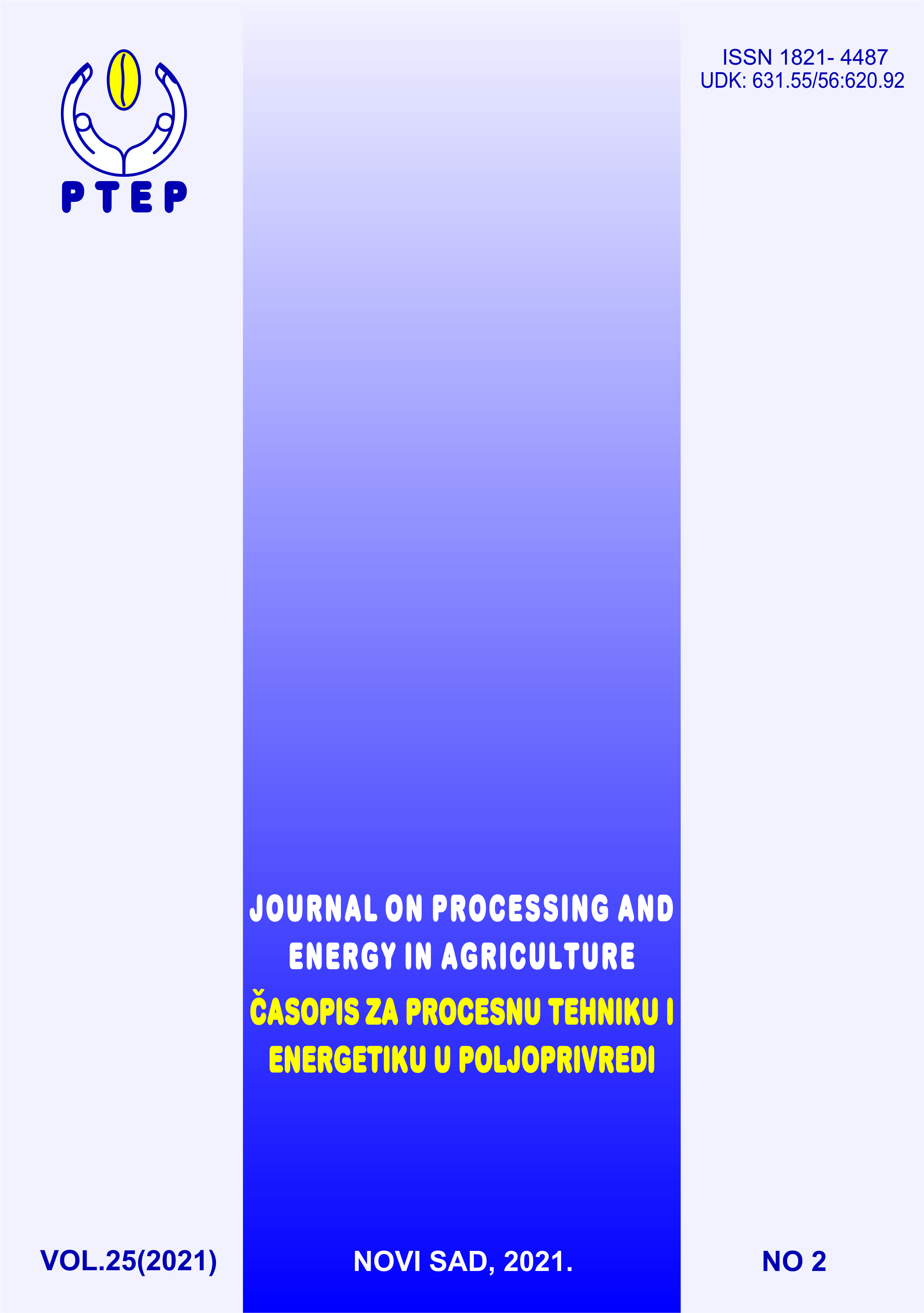STARCH COMPOSITION RELATED TO PHYSICAL TRAITS IN MAIZE KERNEL
Abstract
The focus of this study is on the physical quality traits and starch composition of various maize kernel genotypes grown in Serbia. Furthermore, the aim was to determine the relationship among these quality traits. Results obtained from the Stenvert hardness test showed great variability among the maize samples. The portion of the hard endosperm fraction (HE) ranged from 53.29% to 76.28%. Test weight (TWt) and 1000-kernel weight (KWt) of 10 different ZP maize genotypes ranged from 782.69 to 907.39 kgm-3 and from 128.40 to 376.50 g, respectively. The specialty maize genotypes had the highest content of amylose (27.8% and 28.9%). Yellow dent genotype, ZP 606, had the lowest amylose content in the kernel (22.3%). The results suggested that the composition of starch granule differed depending on the hardness of the endosperm. The amylose content was highly correlated with the physical traits such as TWt, KWt, density and HE.
References
Alcázar-Alay, S. C., Meireles, M. A. A. (2015). Physicochemical properties, modifications and applications of starches from different botanical sources. Food Science and Technology, 35, 2, 215-236. Epub April 00, 2015.https://doi.org/10.1590/1678-457X.6749
Benedetti, M. P., Sartori, J. R., Carvalho, F. B., Pereira, L. A., Fascina, V. B., Stradiotti, A. C., Pezzato, A. C., Costa, C., Ferreira, J. G. (2011). Corn texture and particle size in broiler diets. Brazilian Journal of Poultry Science, 13, 227-234.
Cornejo-Ramírez, Y. I., Martínez-Cruz, O., Del Toro-Sánchez, C. L., Wong-Corral, F. J., Borboa-Flores, J., Cinco-Moroyoqui, F. J. (2018). The structural characteristics of starches and their functional properties. CyTA - Journal of Food, 16, 1, 1003-1017, DOI: 10.1080/19476337.2018.1518343
Gayral, M., Bakan, B., Dalgalarrondo, M., Elmorjani, K., Delluc, C., Brunet, S., Linossier, L., Morel, M.-H., Marion, D. (2015). Lipid partitioning in maize (Zea mays L.) endosperm highlights relationships among starch lipids, amylose, and vitreousness. Journal of Agricultural and Food Chemistry, 63, 3551-3558.
Ignjatovic-Micic, D., Vancetovic, J., Trbovic, D., Dumanovic, Z., Kostadinovic, M., Bozinovic, S. (2015). Grain nutrient composition of maize (Zea mays l.) drought-tolerant populations. Journal of Agricultural and Food Chemistry, 63, 1251−1260.
International Organization for Standardization (ISO). International Standard: ISO 10520. Determination of starch content – Ewers polarimetric method (1997).
Jane, J., Ao, Z., Duvick, S. A., Wiklund, M., Yoo, S.-H., Wong, K.-S., Gardner, C. (2003). Structures of amylopectin and starch granules: how are they synthesized? Journal of Applied Glycoscience, 50, 167-172.
Kljak, K., Duvnjak, M., Grbeša, D. (2018). Contribution of zein content and starch characteristics to vitreousness of commercial maize hybrids. Journal of Cereal Science, 80, 57-62 doi:10.1016/j.jcs.2018.01.010.
Li, C., Huang, Y., Huang, R., Wu, Y., Wang, W. (2018). The genetic architecture of amylose biosynthesis in maize kernel. Plant Biotechnology Journal, 16, 2, 688-695. https://doi.org/10.1111/pbi.12821
McGrance, S. J., Cornell, H. J., Rix, C. J. (1998). A simple and rapid colorimetric method for the determination of amylose in starch products. Starch, 50, 158-163.
Milašinović-Šeremešić, M., Đuragić, O., Radosavljević, M., Dokić, Lj. (2021). Chapter 2, Maize (Zea mays L.) Suitability for Wet Milling and Animal Nutrition in Relation to Physical and Chemical Quality Parameters. In: Zea mays L.: Cultivation, and Uses, Ed: Dunn, S., Nova Science Publishers, USA. https://novapublishers.com/shop/zea-mays-l-cultivation-and-uses/
Milašinović, M., Radosavljević, M., Dokić, Lj., Jakovljević, J. (2007). Wet milling properties of ZP maize hybrids. Maydica, 52, 289-292.
Milašinović-Šeremešić, M., Radosavljević, M., Srdić, J., Tomičić, Z., Đuragić, O. (2019). Physical traits and nutritional quality of selected Serbian maize genotypes differing in kernel hardness and colour. Food and Feed Research, 46, 1, 51-59.
Pomeranz, Y., Czuchjowska, Z., Martin, C. R., Lai, F. (1985). Determination of corn hardness by Stenvert hardness tester. Cereal Chemistry, 62, 108-110.
Preciado-Ortíza, R. E., Vázquez-Carrillob, M. G., Figueroa-Cárdenasc, J. D., Guzmán-Maldonadoa, S. H., Santiago-Ramosd, D., Topete-Betancourtc, A. (2018). Fatty acids and starch properties of high-oil maize hybrids during nixtamalization and tortilla-making process. Journal of Cereal Science, 83, 171-179.
Radosavljevic, M., Bekric, V., Bozovic, I., Jakovljevic, J. (2000). Physical and chemical properties of variuos corn genotypes as a criterion of technological quality. Genetika, 32, 319-329.
Raigond, P., Dutt, S., Singh, B. (2019). Resistant Starch in Food. In: Mérillon JM., Ramawat K. (eds) Bioactive Molecules in Food. Reference Series in Phytochemistry. Springer, Cham. https://doi.org/10.1007/978-3-319-78030-6_30
Semenčenko, V., Mojović, L., Đukić-Vuković, A., Radosavljević, M., Terzić, D., Milašinović-Šeremešić, M. (2013). Suitability of some selected maize hybrids from Serbia for the production of bioethanol and dried distillers' grains with solubles. Journal of the Science of Food and Agriculture, 93, 811-818.
STATISTICA (Data Analysis Software System) (2018). v.13.3., Stat-Soft, Inc., USA (www.statsoft.com).
Trináctý, J., Nedelník, J., Lang, J., Loučka, R., Kučera, J. (2016). Effect of maize kernel endosperm type and maturity stage on ruminal in situ degradability and post-ruminal in vitro dry matter and starch digestibility. Czech Journal of Animal Science, 61, 351-359.
Van Hung, P. , Maeda, T., Morita, N. (2006). Waxy and high‐amylose wheat starches and flours-characteristics, functionality and application. Trends in Food Science and Technology, 17, 448-456.

